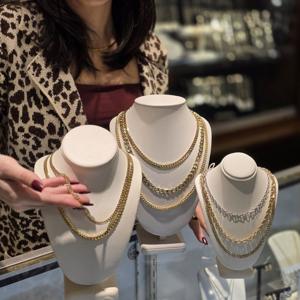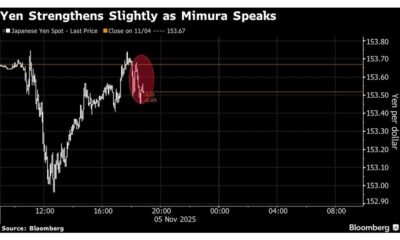Business
Jewellers Adapt to Consumer Sensitivity Amid Rising Gold Prices

Jewellers are navigating a shift in consumer spending behavior this holiday season as gold prices have surged significantly. The price of gold has increased by approximately 55 percent year-to-date, exceeding the US$4,000 per ounce threshold. This rise is prompting business owners to adjust their pricing strategies, anticipating greater price sensitivity from customers during a crucial sales period.
Historically, the holiday season accounts for a substantial portion of annual revenue in the jewelry industry, with gift items forming a key part of sales. Colin Nash, president of the Canadian Jewelry Group and owner of Nash Jewellers, noted that jewellers have universally raised prices to reflect the escalating cost of gold. “Anybody and everybody I believe is raising prices and if they’re not, they should be,” Nash stated, emphasizing the challenges of replacing inventory at current prices.
While consumer spending remains, Nash observes that customers are purchasing less expensive items. He predicts that some shoppers may opt for more affordable sterling silver pieces instead of high-end gold products. This trend reflects broader economic pressures, as rising living costs influence consumer decisions.
James Poag, co-owner of James O. Poag Jewellers, has also noted a shift in purchasing patterns. He remarked, “We’re seeing a lot of lab-grown diamonds and a lot of larger hollow pieces of jewelry as opposed to heavier cast pieces just due to the price of gold.” Additionally, Poag has experienced an uptick in repairs and modifications, with customers choosing to refurbish older jewelry or trade in pieces for new designs rather than buying new.
Jewellery brands are also adapting to the changing landscape. Noura Sakkijha, CEO and co-founder of Mejuri, shared that the company has introduced 10-karat solid gold products to offer more accessible price points. Sakkijha noted that providing a variety of materials, including 10- and 14-karat gold, as well as vermeil and sterling silver, enhances consumer choice. “We also made selective and measured price adjustments on certain 14-karat pieces to reflect raw material increases,” she added.
Nash highlighted that larger brands, including Rolex, Tudor, and Roberto Coin, dictate pricing strategies, often requiring retailers to follow suit on price increases. He explained, “As soon as they say a 10 percent price increase on each of the products, we have to follow suit because the prices here have to match what they’re selling for in Calgary, Vancouver, even in the United States.”
The rapid rise in gold prices presents challenges for jewellers when it comes to pricing their products. Poag described the difficulty of adjusting prices across a large inventory, stating, “We have 2,500 rings, so it literally takes months to go through to do repricing.” He estimates that consumers are currently paying 25 to 40 percent more for items depending on gold content.
December is typically a vital month for jewellers, with sales often accounting for about 20 to 25 percent of annual revenues. As the holiday rush approaches, Nash expressed uncertainty regarding future gold prices, which have recently fluctuated, hitting a peak of US$4,300 in October. “Maybe we hit our ceiling, maybe it’s coming down, but I don’t know,” he said.
Poag shared a similar sentiment, predicting that gold prices are unlikely to decline significantly. He urged consumers not to wait for potential price drops, stating, “I don’t think we’re going to see a significant downward trend.”
As the holiday season unfolds, jewellers must remain agile in response to evolving consumer preferences and the volatile nature of gold prices. This report by The Canadian Press was first published on November 16, 2025.
-

 Politics1 week ago
Politics1 week agoSecwepemc First Nation Seeks Aboriginal Title Over Kamloops Area
-

 World4 months ago
World4 months agoScientists Unearth Ancient Antarctic Ice to Unlock Climate Secrets
-

 Entertainment4 months ago
Entertainment4 months agoTrump and McCormick to Announce $70 Billion Energy Investments
-

 Lifestyle4 months ago
Lifestyle4 months agoTransLink Launches Food Truck Program to Boost Revenue in Vancouver
-

 Science4 months ago
Science4 months agoFour Astronauts Return to Earth After International Space Station Mission
-

 Technology3 months ago
Technology3 months agoApple Notes Enhances Functionality with Markdown Support in macOS 26
-

 Top Stories1 month ago
Top Stories1 month agoUrgent Update: Fatal Crash on Highway 99 Claims Life of Pitt Meadows Man
-

 Sports4 months ago
Sports4 months agoSearch Underway for Missing Hunter Amid Hokkaido Bear Emergency
-

 Politics3 months ago
Politics3 months agoUkrainian Tennis Star Elina Svitolina Faces Death Threats Online
-

 Politics4 months ago
Politics4 months agoCarney Engages First Nations Leaders at Development Law Summit
-

 Technology4 months ago
Technology4 months agoFrosthaven Launches Early Access on July 31, 2025
-

 Top Stories3 weeks ago
Top Stories3 weeks agoFamily Remembers Beverley Rowbotham 25 Years After Murder





















